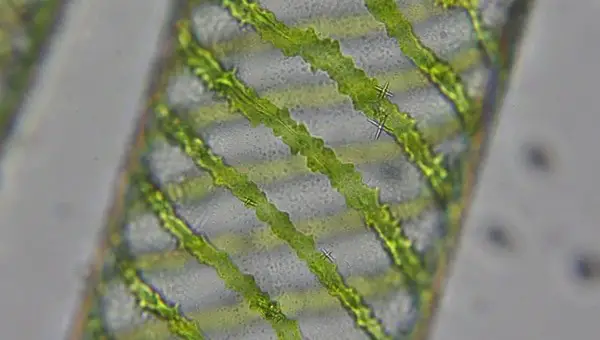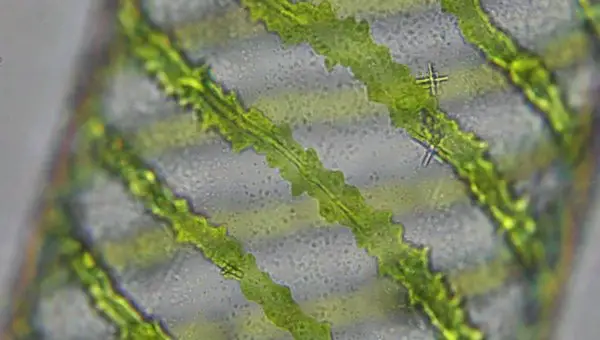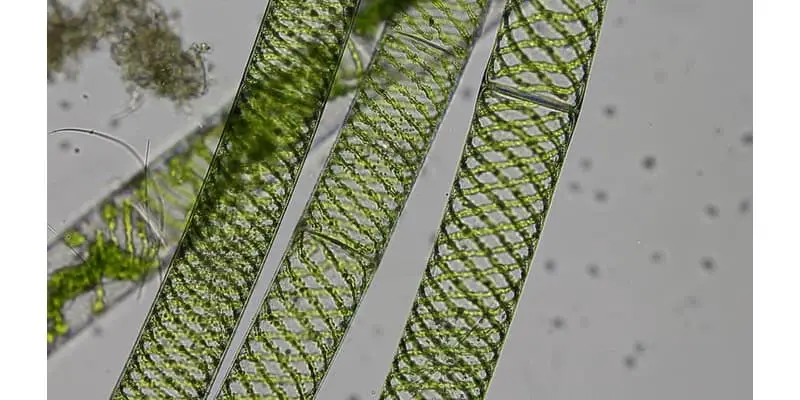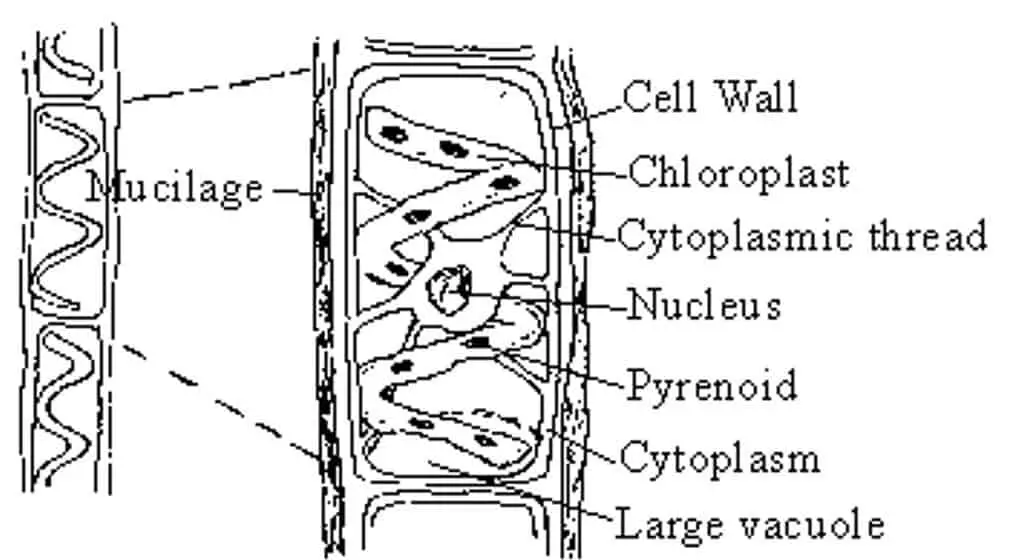Spirogyra are a threadlike microscopic genus of green alga that are known for their helical shape of chloroplasts. These DNA-resembling algae are found in freshwater environments with over 400 species known in existence today. They can range anywhere from 10 to 100 micrometers wide and several centimeters long and are typically found in freshwater environments like shallow ponds and at the edges of lakes.
It’s easily forgotten that algae like Spirogyra are living creatures just like you and I that require energy and can reproduce sexually. Spirogyra are visually magnificent to look at under a microscope but understanding their characteristics, structure, classification will help you appreciate these algae even more when you observe them.
How Are Spirogyra Classified?

Animals and other living organisms are biologically classified based on a ranked system of structurally or phylogenetically related species. Animals are most broadly classified by the Domain. The classification system can further be broken down into (in order) by Kingdom, Phylum, Class, Order, Family, Genus, and Species. Spirogyra are a genus comprised of over 400 species.
Let’s look at how the Spirogyra and classified and examine characteristics that make them unique:
- Domain: Eukaryote – Any cell or organism that has a defined nucleus and surrounding nuclear membrane can be described as a Eukaryote. The nucleus contains well-defined chromosomes that contain hereditary information. Each eukaryotic cell may also contain organelles such as mitochondria (used for cellular energy), Golgi apparatus (secretion), an endoplasmic reticulum (a membrane), and lysosomes (digestive apparatus).
- Kingdom: Plantae – Mainly a group of multicellular photosynthetic eukaryotes, meaning they can turn light into chemical energy to fuel them as food. Chloroplasts assist the Plantae in converting energy thanks to their chlorophylls, which are credited with giving Plantae their green color. There are over 320,000 species of plants and around 290,000 of those produce seeds. There is an entire scientific discipline that revolves around Plantae known as botany.
- Phylum: Chlorophyta – Otherwise known as a taxon of green algae, this phylum is rather small with only 4,300 total known species. About 90% of all of this phylum live within freshwater habitats. They display a wide variety of shapes and sizes. As primary producers, green algae are debatably the most important phylum that helps keep a livable balance on earth. Their ability to uptake carbon dioxide and turn it into oxygen is crucial to our existence on this planet.
- Class: Zygnematophyceae – This class consists of a majority of the 4,300 species within the Chlorophyta. In fact, it consists of around 4,000 total species within the Chlorophyta. It consists of the orders Zygnematales, Desmidales, and Spirogloeales. The body of the Zygnematophyceae appears to have undergone a loss of morphological complexity. Their structure is incredibly simple and appears to have derived from horizontal gene transfer. Sexual reproduction takes place through conjugation.
- Order: Zygnematales – Also known as the conjugates, this order consists of 18 genera with over 600 species. The Spirogyra are amongst the best-known members of this order. Spirogyras are typically used as examples in Biology classes to best describe this order and green algae as a whole. Almost all species live in freshwater and are commonly called ‘pond scum’ since they collect in filamentous mats within water that collects on just about everything that it touches. Zygnematales have plastids which are unique membrane-bound organelles that are responsible for manufacturing food. Members of the Zygnematales produce either asexually by fragmentation or sexually by conjugation.
- Family: Zygnemataceae – This family is made up of filamentous green algae. The filaments are spectated meaning that they are divided. The family is best known for its diversely and beautifully shaped chloroplasts. 95% of Zygnemataceae are found within the Mougeotia, Spirogyra, and Zygnema genera. Conjugation is the main way to identify this species since it is reasonably rare to find in populations within permanent water bodies.
- Genus: Spirogyra – Characteristics of this genus include living within clear eutrophic water, meaning the water is enriched with minerals and other nutrients. Spirogyras develop in slimy filaments that clump together in green masses. In the springtime, Spirogyra grow beneath the water’s surface. When there is enough sunlight and the water becomes warm, they begin producing large amounts of oxygen which carry them to the surface. Spirogyras have cell walls, nuclei, pyrenoids, and notable spiral chloroplasts that resemble a spring or a helix.
- Species – There are approximately 400 species of Spirogyra known today. Take a look at the section below to learn more about the different species of Spirogyra.
What Are the Types Spirogyra?
Species of Spirogyra can be incredibly difficult to define. This is because their defining characteristics are based mostly on sexual reproduction. To properly identify a species of Spirogyra, the reproductive process must be identified in one or more of its stages. Wild-sampled spores can help identify different species.
A list of documented species that are most commonly found among the Spirogyra genus can be found below:
| Common Spirogyra Species |
|---|
| Spirogyra abbreviata |
| Spirogyra acanthophora |
| Spirogyra acumbentis |
| Spirogyra adjerensis |
| Spirogyra adnata |
| Spirogyra adornata |
| Spirogyra aequinoctialis |
| Spirogyra affinis |
| Spirogyra africana |
| Spirogyra ahmedabadensis |
| Spirogyra alpina |
| Spirogyra alternata |
| Spirogyra amplectens |
| Spirogyra ampliata |
| Spirogyra anchora |
| Spirogyra angolensis |
| Spirogyra angulata |
| Spirogyra anomala |
| Spirogyra anzygoapora |
| Spirogyra aphanosculpta |
| Spirogyra aplanospora |
| Spirogyra arcta |
| Spirogyra arcuata |
| Spirogyra areolata |
| Spirogyra arizonensis |
| Spirogyra arthuri |
| Spirogyra articulata |
| Spirogyra asiatica |
| Spirogyra atasiana |
| Spirogyra megaspora |
| Spirogyra meinningensis |
| Spirogyra meridionalis |
| Spirogyra miamiana |
| Spirogyra microdictyon |
| Spirogyra microgranulata |
| Spirogyra micropunctata |
| Spirogyra microspora |
| Spirogyra mienningensis |
| Spirogyra minor |
| Spirogyra minuticrassoidea |
| Spirogyra minutifossa |
| Spirogyra mirabilis |
| Spirogyra miranda |
| Spirogyra mirifica |
| Spirogyra mithalaensis |
| Spirogyra moebii |
| Spirogyra monodiana |
| Spirogyra montserrati |
| Spirogyra multiconjugata |
| Spirogyra multiformis |
| Spirogyra multistrata |
| Spirogyra multitrata |
| Spirogyra mutabilis |
| Spirogyra narcissiana |
| Spirogyra natchita |
| Spirogyra nawaschinii |
| Spirogyra neglecta |
| Spirogyra neorhizobranchialis |
How Do Spirogyra Produce Energy?
Spirogyra do not eat in a traditional sense. Instead, Spirogyra undergoes photosynthesis to harness energy from the sunlight and turn it into usable chemical energy. Photosynthesis can be separated into two categories: oxygenic and anoxygenic. Oxygenic photosynthesis is the most common amongst Spirogyra.
During oxygenic photosynthesis, the energy carried by light transfers energized electrons from water to carbon dioxide. This in turn produces carbohydrates or sugars. During this process, the carbon dioxide is reduced, or receives the electrons, while the water is oxidized, or loses the electrons. Oxygen is produced and released as a result.
This reduction and oxidation process is crucial in keeping a healthy balance of oxygen and carbon dioxide in our atmosphere. Without photosynthetic organisms like Spirogyra that undergo oxygenic photosynthesis, our atmosphere would be much too concentrated with carbon dioxide and would possibly be too toxic to breathe and survive.
Spirogyra are made up of unique cells called stomata that open and close. These stomata help with the intake of carbon dioxide which is used in the chemical conversion process. Stomata are also responsible for releasing oxygen back into the atmosphere. Chlorophyll is responsible for absorbing usable light. They reflect wavelengths in every color aside from green, which is why they appear green to the human eye. The reaction occurs within chlorophyll which produces ATP and NADPH. ATP is used in conjunction with NADPH to drive the most important biosynthetic reactions in the stroma that result in the formation of carbohydrates. Throughout these reactions, water molecules are split, and oxygen is released into the atmosphere.
What is the Structure of Spirogyra?
The structure of Spirogyra can be broken down into the following parts:
- Mucilage: The mucilage is the thick and sticky substance produced by the Spirogyra. Some microorganisms, including protists, are able to use this for locomotion. The direction of locomotion is typically opposite of where the secretion comes from. It plays a huge role in the storage of water, food, and germination. The mucilage is also responsible for secreting a substance that thickens the membrane.
- Cell Wall: The cell wall surrounds the plasma membrane of the plant and is a distinguishable difference between a plant and animal cell. Only plant and algae cells like Spirogyra have cell walls. It provides tensile strength to the organism and serves as a protective layer. The cell wall is the responsible source for turgor pressure, which holds the cellular contents tight up against the cell wall. Cell walls are mostly made up of cellulose, which are long and linear fibers that aggregate into bundles.
The cell wall is typically organized into three main layers, including the primary cell wall, middle lamella, and the secondary cell wall. The primary cell wall gives the structure its support and helps determine the cell’s shape. It resists outward turgor pressure and controls the rate and direction of growth.
The secondary cell wall provides mechanical strength but also expands to allow the cell to grow and divide. This layer is much thicker and stronger, which accounts for the deposition of carbohydrates. The secondary cell wall is attributed to giving a plant its ability to grow upwards and is a major component in things like wood. They can account for most renewable biomasses on earth that can be converted into fuel.
The middle lamella is the layer in between the primary and secondary cell walls that cements the two together. It is the first layer formed after cytokinesis. This layer allows for expansion during growth. This layer is very thin and much less rigid. It’s comparable to a honeycomb-like structure.
- Large Vacuole: Vacuoles are big, fluid-filled vesicles within the cytoplasm. Spirogyras have particularly large vacuoles. These large vacuoles are responsible for about 30 percent of the Spirogyra’s total volume, but they can fill with approximately 90 percent of the intracellular space. Vacuoles are used to adjust the cell’s size and turgor pressure whereas the cytoplasmic volume typically remains the same. Vacuoles may also act as storage containers for nutrients and carbohydrates. For example, proteins are stored in the vacuoles of seeds.
- Chloroplast: These organelles are the beautifully arranges structures within the Spirogyra that give them their unique appearance. In Spirogyra, the chloroplasts are arranged in a spiral or helical pattern. Each cell of the Spirogyra contains one or more spirally shaped chloroplast near the periphery in the cytoplasm and around the nucleus.
The organelle itself is responsible for the process of photosynthesis. Chloroplasts are a type of plastic or an ovular-shaped body that helps with the chemical conversion and storage of sugars. They are best characterized by their green hue which is thanks to its chlorophyll a and chlorophyll b. Each pigment absorbs light that is used in photosynthesis. Other pigments within the chloroplast include carotenoids, which allow light through the organelle and then trap the energy and routing it towards the chlorophyll.
- Cytoplasmic Threads: Otherwise called plasmodesmata, these are small strands that extend from the cytoplasm through the cell wall to help connect adjoining cells. The threads are also responsible for holding the nucleus in place within the cell. They can transport proteins and other signals from the nucleus to the outside of the cell.
- Nucleus: The nucleus is the specialized structure that controls and regulates all of the body’s activities. It also notably carries hereditary information stored within genes. It determines the amino acid sequence of proteins that are essential to the everyday function of the cell. It really acts as the information center of the cell. The nucleus plays a critical role in sharing its genetic code during reproduction.
- Pyrenoid: The pyrenoid is a protein body within the chloroplast of the Spirogyra that helps with carbon fixation and the formation and storage of starches. It promotes photosynthetic carbon dioxide fixation.
- Cytoplasm: One of the most important functions of the cytoplasm is that it allows the cell to hold its shape. Other important functions include its ability to help break down waste thanks to certain enzymes. It assists in metabolic activities and is a jelly-like membrane that joins the nucleus and cell membrane together. All of the Spirogyra’s organelles are suspended within its cytoplasm.
Where Do Spirogyra Live?
Spirogyras are found in freshwater environments like shallow ponds, ditches, and at the edges of lakes. They are generally free-floating and can be found in large mats of other Spirogyra.
Spirogyra are unique in that they are short-lived and are most abundant during periods of wet weather. They are known to dry up very quickly. Spirogyras live in mostly eutrophic water bodies. Eutrophic water bodies are characterized by water bodies that are becoming progressively rich in minerals and nutrients. The water is typically very clear because of this. Eutrophication can ultimately lead to harmful algal blooms, dead zones, and fish kills. During the wet months, small filaments first appear in mostly stagnant water.
You can find Spirogyra commonly in acidic ponds, lakes, or slow-moving streams and estuaries. Spirogyras begin their lives underneath the surface of the water. Once they mature and grow, they begin to release more and more oxygen which ultimately carries them in mats towards the surface. Once at the surface, Spirogyra mats quickly dry up.
How Do Spirogyra Reproduce?
Spirogyras can reproduce in three different ways: vegetatively, asexually, and sexually. Vegetative reproduction occurs through fragmentation. Asexual reproduction occurs through three different asexual spores. Sexual reproduction occurs through conjugation by the zygospore.
Fragmentation is the most common way that a Spirogyra reproduces. Fragmentation occurs during the splitting of cells into two parts that make their own bodies. Each fragment grows into its own mature Spirogyra that is genetically identical to its parent. This results from just about any mechanical damage to the parent Spirogyra. Even a Spirogyra’s death can result in fragmentation.
Asexual reproduction is much less common. It occurs only in unfavorable conditions where the Spirogyra has no other choice in order to preserve nutrients or doesn’t have any other Spirogyra around to reproduce sexually with. There are mainly three types of spores that aid in asexual reproduction:
- Akinetes: A thick-walled spore that forms when conditions are unfavorably harsh. The thick wall helps protect from the unfavorable surrounding environment. Akinetes are characterized by their small, shrunken, and rounded appearance that results from a lack of water.
- Aplanospore: A thin-walled spore that forms under unfavorable conditions. The thin wall is secreted and forms a single cell. These are commonly released after the death of a mother’s filament and germinates into its own filament once conditions are favorable again.
- Azygospore: Also known as a Parthenospore, these form due to physical conditions when the gametes don’t properly fuse and ultimately end up behaving as a spore.
Sexual reproduction occurs by the formation of the zygospore during favorable conditions. Conjugation is characterized as the fusion of a couple of gametes that are produced by two separate Spirogyra. One is designated as the male whereas the other is designated as the female. The male gamete is motile whereas the female gamete is not.
There are two different ways that a Spirogyra can sexually reproduce. First is known as scalariform, which occurs between two cells of different Spirogyra when the two are attracted towards one another and pull each other together in a parallel formation. A papillae reaches across from one Spirogyra to the other while the second Spirogyra forms a conjugation tube. The resulting process looks much like a ladder when the papillae is extended into the conjugation tube.
Lateral conjugation is the second form of sexual reproduction via conjugation. This occurs between two separate cells of the same Spirogyra filament. Two adjacent cells reproduce through either indirect lateral conjugation or direct lateral conjugation. Direct lateral conjugation is less common and thought to have been the primitive mode of reproduction.
How to Observe Spirogyra Under the Microscope

Spirogyra can grow several centimeters in length which makes them visible to the naked eye. My recommendation when observing spirogyra is to cut it down to a small length so that it does not extend past the slide coverslip. Spirogyra can tend to clump together, and it can be difficult to get a single strand so make sure you use tweezers and get as small of a sample as possible. Since spirogyra are relatively large compared to other microorganisms you will be able to see the helical shaped chloroplasts under about 100X magnification.
Spirogyra History
Remarkably, Spirogyra were possibly the very first microorganisms ever studied by the Dutch scientist known as Antoine van Leeuwenhoek. Originally a businessman, Leeuwenhoek was largely self-taught in the sciences. He is known best for his pioneering work in microscopy and is known as the ‘Father of Microbiology’.
Leeuwenhoek worked mainly as a clothing retailer when he was young. He eventually opened his own store in 1654 and became interested in lens making. In fact, Leeuwenhoek is credited with inventing over 400 different types of lenses. Leeuwenhoek used these lenses to explore the microbial world that was suddenly visible to him.
According to a biographical excerpt of Leeuwenhoek’s, he was once two hours away from his town on an inland lake called Berkelse Mere. The bottom of Berkelse Mere was marshy and boggy but the water itself was very clear. Leeuwenhoek noticed ‘little green clouds’ floating through the water which he collected and brought home to examine.
Leeuwenhoek writes, “I found floating therein divers earthy particles, and some green streaks, spirally wound serpent-wise, and orderly arranged, after the manner of the copper or tin worms, which distillers use to cool their liquors as they distil over. The whole circumference of each of these streaks was about the thickness of a hair of one’s head. Other particles had but the beginning of the foresaid streak; but all consisted of very small green globules joined together: and there were very many small green globules as well.”
Incredibly, the organism with green streaks that is described is thought to be the first-ever documented observation of the Spirogyra. What is even more incredible is that this observation of the Spirogyra gave birth to the entire discipline of microbiology itself.
A famous protozoologist, one of the first in human history known as Clifford Dobell, worked under Leeuwenhoek. Dobell is credited with putting names to the descriptions for many of the microorganisms described by Leeuwenhoek. The Spirogyra in particular was named thanks to its spirally arranged green streaks as a filamentous alga that has coiled chloroplasts. There is some debate as to whether Leeuwenhoek was describing the Spirogyra or if it was actually microorganisms known as Arthrospira or Spirulina, which are similar in appearance to filamentous cyanobacteria. It’s a contentious topic amongst the microbiology community and we may never know the true answer.
Takeaways
Spirogyra are not as exciting as most microorganisms that are moving around, eating, and conjugating but if you can appreciate the detail in intricate artwork you will appreciate the beautiful detail in the natural chloroplast patterns that make Spirogyra famous. Spirogyra are easy to find if you have a pond or lake nearby and they are visible to the naked eye so you will actually be able to see them. Go out today, find a sample, observe it under your microscope, and have fun!
References
- https://www.sciencedirect.com/topics/agricultural-and-biological-sciences/chlorophyta
- http://www.microscopy-uk.org.uk/mag/artfeb16/wimleeuwenhoek2.html
- https://ucmp.berkeley.edu/greenalgae/charophyta/zygnematales.html
- https://www.nature.com/articles/s41598-019-43454-6#:~:text=The%20genus%20Spirogyra%20is%20abundant,and%20comprises%20approximately%20380%20species.
- http://bioweb.uwlax.edu/bio203/2010/fenske_megh/nutrition.htm#:~:text=Spirogyra%20Longata%20use%20this%20process,algae’s%20life%2C%20on%20to%20Reproduction!
- https://www.nature.com/scitable/topicpage/plant-cells-chloroplasts-and-cell-walls-14053956/
- https://www.ccrc.uga.edu/~mao/intro/ouline.htm
- https://byjus.com/biology/cytoplasm-structure-function/
- https://www.seaweed.ie/algae/spirogyra.php#:~:text=Spirogyra%20is%20a%20large%20genus,%2C%20generally%20growing%20free%2Dfloating.
- https://qsstudy.com/biology/the-characteristics-and-habitat-of-plant-spirogyra


